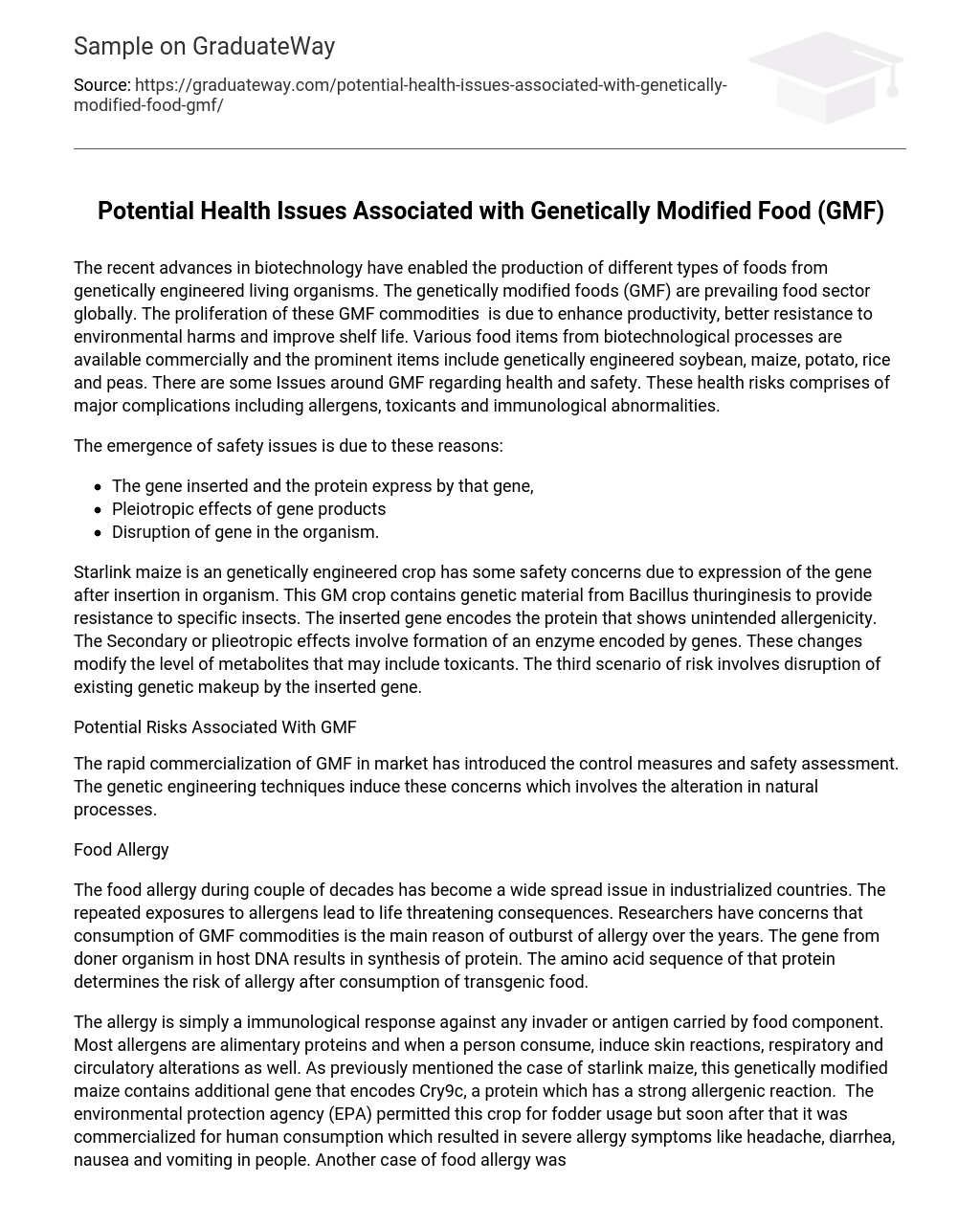The recent advances in biotechnology have enabled the production of different types of foods from genetically engineered living organisms. The genetically modified foods (GMF) are prevailing food sector globally. The proliferation of these GMF commodities is due to enhance productivity, better resistance to environmental harms and improve shelf life. Various food items from biotechnological processes are available commercially and the prominent items include genetically engineered soybean, maize, potato, rice and peas. There are some Issues around GMF regarding health and safety. These health risks comprises of major complications including allergens, toxicants and immunological abnormalities.
The emergence of safety issues is due to these reasons:
- The gene inserted and the protein express by that gene,
- Pleiotropic effects of gene products
- Disruption of gene in the organism.
Starlink maize is an genetically engineered crop has some safety concerns due to expression of the gene after insertion in organism. This GM crop contains genetic material from Bacillus thuringinesis to provide resistance to specific insects. The inserted gene encodes the protein that shows unintended allergenicity. The Secondary or plieotropic effects involve formation of an enzyme encoded by genes. These changes modify the level of metabolites that may include toxicants. The third scenario of risk involves disruption of existing genetic makeup by the inserted gene.
Potential Risks Associated With GMF
The rapid commercialization of GMF in market has introduced the control measures and safety assessment. The genetic engineering techniques induce these concerns which involves the alteration in natural processes.
Food Allergy
The food allergy during couple of decades has become a wide spread issue in industrialized countries. The repeated exposures to allergens lead to life threatening consequences. Researchers have concerns that consumption of GMF commodities is the main reason of outburst of allergy over the years. The gene from doner organism in host DNA results in synthesis of protein. The amino acid sequence of that protein determines the risk of allergy after consumption of transgenic food.
The allergy is simply a immunological response against any invader or antigen carried by food component. Most allergens are alimentary proteins and when a person consume, induce skin reactions, respiratory and circulatory alterations as well. As previously mentioned the case of starlink maize, this genetically modified maize contains additional gene that encodes Cry9c, a protein which has a strong allergenic reaction. The environmental protection agency (EPA) permitted this crop for fodder usage but soon after that it was commercialized for human consumption which resulted in severe allergy symptoms like headache, diarrhea, nausea and vomiting in people. Another case of food allergy was related to genetically modified soybean that had a gene from Brazil nut to enrich methionine content. some studies observed the genetically modified tea nuts and peanut the leading cause of food allergy.
Toxicity
The toxicity produced by GMF is a considerable issue to health and life of consumer. There are anti alimentary toxic products that may produce in cells or tissues and increase the risk of neoplastic abnormalities.
In Spain during 1980s, consumption of genetically modified rapeseed oil caused several deaths of consumers. Before permitted to market it was tested on Rats but produced no disturbance in organism health. This tragedy stimulated heat of investigations to explain the issue. The oil contaminated with aniline and its derivatives, was the leading cause of toxicity also called toxic oil syndrome (TOS). In United States during 1989 where the causative agent of toxicity was transgenic tryptophan which became the cause of severe joint pain and deaths.
Tumor Formation
Tumor formation is also related to the consumption of GMF. The increased amount of IGF-1 factor in milk associated with genetically modified cows showed a positive correlation with tumor development in colon, lungs and breast. Various studies indicate that consumption of products derived from transgenic crop with resistant gene to pesticides, has a tendency to form lymphoma. The MON810 (GM maize) which has a potential to cause harm on pancreas, liver and intestines. This maize produces Bt toxin to kill pests and has ability to induce histopathological lesions in liver and kidney. The GM Potatoes produce lectin which was thought to be toxic for mammal’s growth and development. There is a risk of abnormality of alimentary canal when consumed lectin containing diet.
Antibiotic Resistance
This phenomenon develops due to marker antibiotics after insertion during genetic engineering and these resist strongly against antibiotics. The marker antibiotics indicate the completion of safe transfer of foreign genetic material into the host. After consuming food derived from GMOs, there is a risk of transport of antibiotic resistance to microbes of human gut which may contain some pathogenic forms. In consequence, pathogens inducing various diseases may develop a stable lack of sensitivity to specific antibiotics. The report of the European Union (EU) stated that the acceptance of antibiotic resistance genes from modified plants to environmental microbes, may be possible. Therefore, the report recommended that only genes coding for antibiotics not used in human and veterinary medicine should be allowed to use when making GM plants.
Conclusion
GM foods have great potential to solve malnutrition and hunger concerns in developing nations. GMF assist in protection and preservation of the environment by enhancing productivity and reducing dependence upon herbicides and pesticides usage. Therefore, it is necessary to move ahead carefully to prevent undesirable consequences for health and surroundings, considering genetic modification technology as powerful tool.





